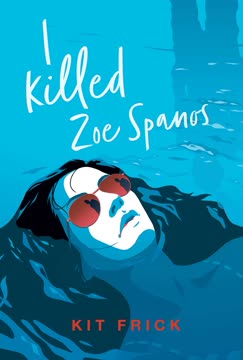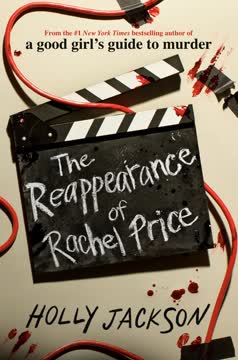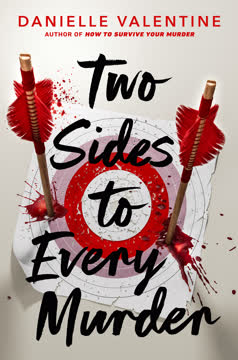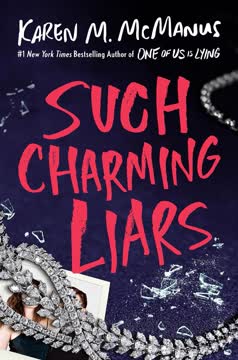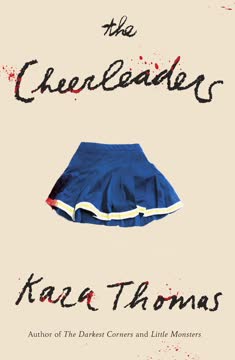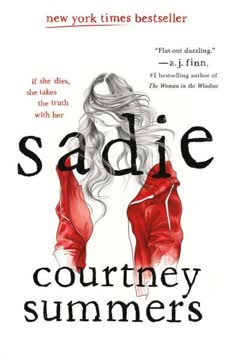Plot Summary
Arrival in Herron Mills
Anna Cicconi, a Brooklyn teen with a troubled past, arrives in the elite Hamptons village of Herron Mills to nanny for the Bellamy family. She's determined to reinvent herself, leaving behind a history of partying and mistakes. The Bellamys' world is one of privilege and order, a stark contrast to Anna's chaotic home life. As Anna settles into her summer job, she's struck by the beauty and strangeness of her new environment, but also by a persistent sense of déjà vu. She's haunted by the feeling that she's been here before, even though she can't recall any specific memories of the place.
Doppelgänger in the Hamptons
Anna quickly learns that she bears an uncanny resemblance to Zoe Spanos, a local girl who went missing on New Year's Eve. The townspeople, especially children and shopkeepers, are startled by Anna's appearance, often mistaking her for Zoe. This resemblance is more than superficial; Anna feels a strange connection to Zoe, as if their lives are intertwined. The Bellamys admit Anna was hired partly because of this likeness, which comforted their daughter Paisley, who was once babysat by Zoe. Anna's sense of self becomes increasingly blurred as she's drawn deeper into Zoe's lingering mystery.
The Missing Girl's Shadow
The mystery of Zoe's disappearance permeates Herron Mills. Through conversations and a local podcast, Anna learns that Zoe was a beloved, high-achieving college student who vanished after supposedly heading to a party. The police initially treat Zoe as a runaway, but her family and friends insist she would never leave without a word. The case is cold, but the community's grief and suspicion remain raw. Anna's presence, as Zoe's lookalike, stirs up old wounds and new questions, especially as she begins to experience flashes of memories that don't seem to be her own.
Podcasting for the Truth
Martina Jenkins, a driven local teen and aspiring journalist, launches a true-crime podcast, "Missing Zoe," determined to uncover what really happened. Martina interviews Zoe's friends, family, and townspeople, exposing flaws in the police investigation and exploring theories ranging from runaway to foul play. The podcast becomes a sensation, drawing national attention and putting pressure on the authorities. Martina's relentless pursuit of the truth makes her both a hero and a target in the community, and her friendship with Zoe's younger sister, Aster, gives her unique access—and responsibility.
Confession Under Pressure
After a summer of mounting anxiety and fragmented memories, Anna is brought in for police questioning. Under intense, prolonged interrogation—without a lawyer or her mother present—Anna confesses to accidentally causing Zoe's death. She claims they were drinking together at Windermere, the Talbot family estate, and that Zoe fell from a balcony. Anna says she panicked, hid Zoe's body in a boat, and sank it in a nearby lake. But her confession is riddled with uncertainty, gaps, and "I don't remembers." The police, eager for closure, accept her story, but Anna's friends and even some locals sense something is off.
Summer of Secrets
As Anna awaits trial in juvenile detention, she's plagued by confusion and guilt. Her memories of New Year's Eve are hazy, and her best friend Kaylee insists Anna was never in Herron Mills that night. Anna's sense of reality fractures as she tries to reconcile her confession with what she actually remembers. Meanwhile, Martina's podcast gains traction, and new evidence emerges: Anna and Zoe had exchanged messages before Zoe disappeared, and Anna's memories of Herron Mills may be rooted in a forgotten childhood connection. The lines between truth, memory, and suggestion blur dangerously.
The Boyfriend Theory
Caden Talbot, Zoe's boyfriend, is scrutinized by both the police and Martina's podcast. Though he has an alibi for New Year's Eve, rumors swirl about his relationship with Zoe and a possible affair with another girl, Tiana. Caden's grief is complicated by guilt and suspicion, and he's further isolated by the town's subtle racism and the pressure of being a person of interest. Anna's interactions with Caden are fraught with tension, as she uncovers evidence of his secrets and wonders if he knows more than he's saying.
The Stable's Hidden Evidence
Anna discovers a hidden flash drive and an apology card in the Windermere stable, both linked to Caden and Zoe. The flash drive contains intimate emails and photos between Caden and Tiana, revealing that Zoe knew about the affair. Anna and Martina realize the flash drive was meant as a warning to Caden, but it also becomes a key piece of evidence. When the stable is mysteriously set on fire, Anna suspects someone is trying to destroy the truth. The fire marks a turning point, escalating the stakes and deepening the mystery.
Fire and Fallout
The stable fire draws police attention, but no one is charged. Anna's relationship with Caden deteriorates, and she becomes increasingly isolated. Meanwhile, Aster, Zoe's younger sister, is seen lurking around Windermere and acting erratically. Martina and Anna begin to suspect Aster knows more than she's letting on. The community's grief turns to anger as the investigation stalls, and Anna's mental state worsens under the weight of suspicion and her own unreliable memories.
Fractured Memories
Anna's sense of self shatters as she uncovers the truth about her connection to Herron Mills and Zoe. She learns that she and Zoe are half-sisters, sharing the same father, George Spanos. Childhood memories of summers in Herron Mills, long suppressed by her mother's secrecy, resurface. Anna realizes her memories of Zoe are real, but from early childhood, not the night of Zoe's disappearance. This revelation explains her uncanny familiarity with the town and her deep, inexplicable bond with Zoe.
The Sister's Guilt
After a series of confrontations and mounting evidence, Aster confesses to her role in Zoe's death. She admits to planting the flash drive in Caden's stable as a warning, never imagining Zoe would find it and drink the whiskey laced with her mother's painkillers. Aster panicked when she found Zoe dead, and in a desperate attempt to protect herself and her family, she staged Zoe's disappearance as a runaway, sinking her body in the lake. Aster's actions were driven by love, jealousy, and a tragic misunderstanding.
The Truth in Ashes
With Aster's confession, the pieces finally fall into place. Zoe's death was a tragic accident, the result of a toxic mix of alcohol and medication, not murder. Anna's confession is revealed as a product of police coercion, trauma, and her own fractured psyche. The stable fire, set by Aster to destroy evidence, is exposed. The community is forced to confront the consequences of their assumptions, the failures of the police, and the dangers of seeking easy answers in the face of complex truths.
The Real Anna Cicconi
Freed from detention, Anna returns home to Brooklyn, forever changed by her summer in Herron Mills. She grapples with the aftermath of her false confession, her rediscovered family ties, and the loss of Zoe. Anna's journey is one of self-forgiveness and healing, as she learns to separate her own story from the shadows of others. She reconnects with her mother, her friends, and the truth of her past, determined to move forward.
The Final Podcast
Martina's final episodes of "Missing Zoe" document the unraveling of the case, Aster's confession, and the community's reckoning. The podcast, once a tool for seeking justice, becomes a means of understanding, empathy, and closure. Martina reflects on the power and responsibility of storytelling, the limits of true crime, and the importance of listening to those most affected by tragedy. The podcast's legacy is not just in solving a mystery, but in giving voice to the silenced and the misunderstood.
Justice and Aftermath
In the aftermath, the Spanos family and the town of Herron Mills struggle to heal. Aster faces legal consequences but is shown compassion as a minor who made a terrible mistake. Anna, Martina, and the other young women at the heart of the story reckon with the trauma, guilt, and lessons of the summer. The novel ends with a sense of hope and renewal, as Anna prepares for college and a new chapter, determined to live her own life, not just as a shadow of Zoe Spanos.
Characters
Anna Cicconi
Anna is a seventeen-year-old from Brooklyn, desperate for a fresh start after a troubled adolescence. Intelligent but emotionally fragile, she's drawn to Herron Mills by a job and an inexplicable sense of déjà vu. Anna's resemblance to Zoe Spanos and her fragmented memories make her both a suspect and a victim in the unfolding mystery. Her journey is one of self-discovery, as she uncovers her true connection to Zoe and learns to trust her own story. Anna's psychological complexity—her guilt, confusion, and longing for belonging—drives the novel's emotional core.
Zoe Spanos
Zoe is the beautiful, high-achieving girl whose disappearance haunts Herron Mills. Seen through the memories and stories of others, she is both real and mythic—a symbol of lost innocence and the dangers lurking beneath perfection. Zoe's struggles with anxiety, her complicated relationships, and her secret knowledge of her boyfriend's betrayal make her a deeply human figure. Her accidental death is the tragic fulcrum around which the novel turns.
Martina Jenkins
Martina is a local teen journalist and podcaster, determined to uncover the truth about Zoe's disappearance. Her podcast, "Missing Zoe," is both a narrative device and a symbol of the power—and limits—of storytelling. Martina's friendship with Aster and her evolving relationship with Anna give her unique access to the case. She is both investigator and participant, forced to confront her own biases and the consequences of her pursuit.
Aster Spanos
Aster is Zoe's younger sister, fiercely protective and deeply affected by her loss. Her actions—planting the flash drive, lacing the whiskey, and ultimately concealing Zoe's body—are driven by love, jealousy, and a desperate need to control what she cannot. Aster's confession is the key to the novel's resolution, and her psychological unraveling is both heartbreaking and illuminating.
Caden Talbot
Caden is Zoe's boyfriend, a biracial Yale student caught between suspicion and sorrow. His complicated relationship with Zoe, his affair with Tiana, and his isolation in the wake of her disappearance make him a figure of both empathy and ambiguity. Caden's struggle with grief, guilt, and the town's subtle racism adds depth to the novel's exploration of privilege and prejudice.
Kaylee Harrison
Kaylee is Anna's best friend from Brooklyn, fiercely loyal but also blunt and unsentimental. She challenges Anna's memories and pushes her to confront the truth about New Year's Eve. Kaylee's own guilt over a friend's disappearance in Brooklyn parallels Anna's journey, highlighting the novel's themes of memory, responsibility, and the limits of friendship.
Max Adler
Max is a Brown graduate and minor love interest who becomes a person of interest in the case. His flirtation with both Zoe and Anna, his presence at key moments, and his self-serving behavior make him a classic red herring. Max's testimony ultimately helps clarify the timeline and exonerate Anna.
Meredith Talbot
Caden's mother, Meredith, is a once-vibrant woman now struggling with mental illness and the decline of the family estate. Her love for Zoe and her desire to protect Caden make her both a sympathetic and unsettling presence. Meredith's actions—her warnings, her isolation—reflect the novel's themes of family, loss, and the corrosive effects of secrets.
George Spanos
Zoe and Aster's father, and secretly Anna's biological father, George is a figure of both authority and failure. His inability to confront the truth about his past and his daughters' connections contributes to the novel's central tragedy. George's grief and guilt are palpable, and his eventual acknowledgment of Anna is both a moment of healing and regret.
Paisley Bellamy
The Bellamys' young daughter, Paisley, is both a source of comfort and a catalyst for Anna's involvement in the mystery. Her memories, observations, and emotional needs drive key plot points, and her innocence stands in stark contrast to the adult world's complexity and pain.
Plot Devices
Dual Timelines and Unreliable Narration
The novel alternates between "Then" and "Now," blending Anna's present-day experiences with flashbacks and podcast transcripts. This structure creates suspense and mirrors Anna's psychological state, as her memories are revealed to be unreliable, manipulated by trauma, suggestion, and suppressed truths. The reader is kept off-balance, forced to question what is real and what is imagined.
The True-Crime Podcast
Martina's podcast, "Missing Zoe," serves as both a plot device and a commentary on the ethics of true crime. It exposes the failures of the police, the dangers of public speculation, and the power of storytelling to shape reality. The podcast's transcripts provide exposition, multiple perspectives, and a sense of immediacy, while also critiquing the genre's limitations.
Doppelgänger Motif and Identity Confusion
Anna's resemblance to Zoe is both a literal plot point and a metaphor for the ways in which young women's identities are shaped, borrowed, and erased by others' expectations. The motif of mistaken identity, déjà vu, and suppressed childhood memories underscores the novel's exploration of selfhood, trauma, and the search for belonging.
Red Herrings and Misdirection
The narrative is filled with red herrings—Caden's affair, Max's flirtations, the stable fire, Anna's confession—that keep the reader guessing. Each apparent solution is complicated by new evidence, unreliable memories, and shifting perspectives, reflecting the complexity of real-life investigations and the dangers of easy answers.
Thematic Use of Setting and Symbolism
The Hamptons setting is both idyllic and menacing, a place of privilege hiding rot beneath the surface. Water—lakes, pools, the ocean—recurs as a symbol of memory, danger, and the unconscious. The Windermere estate, with its decaying grandeur and hidden secrets, embodies the novel's gothic undertones and the corrosive effects of secrets.
Analysis
I Killed Zoe Spanos is a sophisticated, psychologically rich mystery that interrogates the nature of truth, memory, and justice in the age of true crime. Kit Frick uses the conventions of the genre—missing girls, unreliable narrators, podcasts, and red herrings—not just to entertain, but to critique the ways in which stories are constructed, consumed, and weaponized. The novel's central mystery is less about "whodunit" than about how trauma, guilt, and secrecy can warp reality for both individuals and communities. By centering the voices of young women—Anna, Martina, Aster—the book explores the pressures of perfection, the dangers of being unseen or misunderstood, and the desperate need for connection and forgiveness. Ultimately, the novel argues that justice is not just about punishment, but about truth, empathy, and the courage to face the past, no matter how painful.
Last updated:
FAQ
Synopsis & Basic Details
What is I Killed Zoe Spanos about?
- A Summer of Unraveling: The novel follows Anna Cicconi, a Brooklyn teen seeking a fresh start as a nanny in the Hamptons, only to find herself entangled in the cold case of Zoe Spanos, a local girl who vanished months earlier. Anna's uncanny resemblance to Zoe and fragmented memories lead her to confess to Zoe's accidental death, despite her own uncertainty.
- Podcast-Driven Investigation: The narrative is propelled by "Missing Zoe," a true-crime podcast hosted by aspiring journalist Martina Jenkins, which meticulously re-examines Zoe's disappearance and challenges the official police narrative. This meta-narrative device allows for multiple perspectives and a critique of how true crime stories are constructed.
- Hidden Paternity & Tragic Accident: The core mystery unravels to reveal that Anna and Zoe are half-sisters, sharing the same father, George Spanos. Zoe's death is ultimately revealed to be a tragic accident, caused by her younger sister Aster, who, in a misguided attempt to punish Zoe's cheating boyfriend, laced his whiskey with her mother's painkillers, which Zoe then consumed.
Why should I read I Killed Zoe Spanos?
- Psychological Depth & Unreliable Narration: Readers who enjoy complex character studies and narratives that challenge their perceptions will be drawn to Anna's journey through fragmented memories and identity confusion. The novel masterfully uses an unreliable narrator to keep readers guessing, making the eventual revelations deeply impactful.
- Critique of True Crime Culture: The book offers a smart, timely commentary on the ethics and impact of true-crime podcasts and media, exploring how public narratives can shape investigations and influence public opinion. It's a must-read for those interested in the genre's societal implications.
- Rich Thematic Exploration: Beyond the mystery, the novel delves into themes of class, privilege, family secrets, the pressures on young women, and the search for identity. The Hamptons setting, with its veneer of perfection, serves as a powerful backdrop for these deeper explorations, making it a compelling read for fans of literary thrillers.
What is the background of I Killed Zoe Spanos?
- Inspired by Classic Gothic & Modern True Crime: Author Kit Frick explicitly states in the acknowledgments that the novel was born from a desire to marry Daphne du Maurier's classic thriller Rebecca with the contemporary true-crime podcast boom. This blend creates a unique atmosphere of romantic seaside intrigue mixed with journalistic immediacy.
- Long Island's Dual Nature: The setting of Herron Mills in the Hamptons is crucial, portraying the East End of Long Island not just as a playground for the wealthy, but also as a place with a rich, textured history, including agrarian roots and diverse communities like the Shinnecock Reservation. This contrasts with the superficial "wealth, celebrity, privilege" often associated with the Hamptons, adding depth to the story's social commentary.
- Focus on Youth & Social Media: The novel is deeply embedded in the contemporary youth experience, utilizing social media (Instagram, Messenger) and podcasts as integral plot devices. This reflects how modern teens interact, investigate, and form identities, making the story resonate with current cultural trends and anxieties.
What are the most memorable quotes in I Killed Zoe Spanos?
- "It's very difficult to keep the line between the past and the present. Do you know what I mean?": This opening quote, attributed to Edith "Little Edie" Bouvier Beale from Grey Gardens, perfectly encapsulates the novel's central theme of fractured memory and the blurring of timelines. It immediately sets the stage for Anna's struggle with her past and her connection to Zoe.
- "You're a story, but that doesn't make you any less true.": This quote, from Melissa Albert's The Hazel Wood, serves as the epigraph for Part IV, "A Body." It speaks directly to the novel's meta-narrative, highlighting how narratives (like Martina's podcast or Anna's memories) shape understanding and can hold profound truth, even if not strictly factual. It underscores the power of storytelling in the search for justice and identity.
- "I killed Zoe Spanos.": Anna's chilling confession, repeated multiple times throughout the narrative, is the driving force of the initial mystery. It's memorable not just for its starkness, but for the layers of meaning it accumulates as the truth unravels, ultimately revealing the complex interplay of guilt, suggestion, and a desperate need for answers.
What writing style, narrative choices, and literary techniques does Kit Frick use?
- Alternating "Then" and "Now" Structure: Frick employs a dual timeline, shifting between Anna's present-day incarceration and her past summer in Herron Mills. This non-linear approach builds suspense, gradually revealing information and mirroring Anna's fragmented memory, keeping the reader constantly re-evaluating events.
- Integration of Multimedia Elements: The novel seamlessly weaves in podcast transcripts, text messages, and social media interactions. This innovative technique not only grounds the story in a contemporary context but also provides multiple perspectives and a meta-commentary on how information is consumed and narratives are shaped in the digital age.
- Sensory-Rich and Evocative Language: Frick uses vivid descriptions and sensory details to immerse the reader in Anna's psychological state and the Hamptons setting. From the "thin cry of seagulls" to the "stench of privilege," the language creates a strong atmosphere, enhancing the emotional impact and the sense of unease that permeates the story.
Hidden Details & Subtle Connections
What are some minor details that add significant meaning?
- Paisley's Dog's Name, Julia Child: When Anna first meets Aster's dog, she mistakenly calls her "Belle," a name that Aster corrects to "Julia Child." Later, Anna's childhood memories reveal that Zoe's bichon frise puppy was named "Belle." This subtle detail foreshadows Anna's deep, forgotten connection to the Spanos family and her shared past with Zoe, hinting at the true nature of their relationship.
- Emilia's Pixie Cut in Old Photo: While snooping in Emilia's office, Anna finds an old photo of Emilia with a pixie cut, embracing an older woman with dark, waist-length hair. This seemingly throwaway detail later connects to Emilia's confession of a past affair with Joan Spanos, Zoe's mother, explaining Emilia's discomfort when Joan is mentioned and adding a layer of hidden romantic history to the seemingly perfect Bellamy family.
- The "Chocolate Caramel Popcorn" Ice Cream: Anna's inexplicable craving for this specific flavor at Jenkins' Creamery, despite not usually liking caramel, is a seemingly minor quirk. It's later revealed to be Zoe's favorite flavor, a detail Anna "remembers" from their shared childhood summers, subtly hinting at the deep, subconscious connections Anna has to Zoe long before she understands their familial bond.
What are some subtle foreshadowing and callbacks?
- Anna's Vertigo at Windermere Balcony: Early in the novel, Anna experiences a sudden, intense wave of vertigo while looking up at the Windermere balcony, feeling like she's "falling." This subtly foreshadows her later "memory" of Zoe falling from that very balcony, and the eventual revelation that Anna herself was dangled over that railing as a child by George Spanos, linking her physical sensation to a traumatic, suppressed event.
- Kaylee's "Sink Your Own Ship" Comment: During a phone call with Anna in Pathways, Kaylee angrily tells Anna, "You want to sink your own ship, fine." This seemingly casual idiom becomes a chilling callback to Anna's confession of sinking Zoe's body in a boat, and later, Aster's actual act of sinking Zoe's body in the motorboat, highlighting the recurring motif of water and concealment.
- Meredith Talbot's Parasol as a Weapon: When Mrs. Talbot confronts Anna at the party, her parasol is described as being used "as a cane," but later, when she confronts Martina and Aster in the stable ruins, it's described as "the length of a hunting rifle" and "a makeshift cane." This subtle shift in description foreshadows Mrs. Talbot's protective, almost aggressive nature when her son is threatened, and the potential for seemingly innocuous objects to become menacing in moments of high tension.
What are some unexpected character connections?
- Emilia Bellamy and Joan Spanos's Past Relationship: It's revealed that Emilia, Anna's employer, had a romantic relationship with Joan Spanos, Zoe's mother, years before Emilia met Tom. This unexpected connection adds a layer of hidden history and emotional complexity to the seemingly perfect Hamptons community, explaining Emilia's guarded reactions whenever Joan is mentioned and highlighting the intricate web of relationships beneath the surface.
- Max Adler's Unrequited Love for Zoe: Max, initially presented as a charming but opportunistic love interest for Anna, is later revealed to have harbored a strong, unrequited affection for Zoe at Brown. This connection explains his presence at Windermere on New Year's Eve and his knowledge of Zoe's distress over Caden's affair, making him a crucial, albeit self-serving, witness to Zoe's final hours.
- Caden Talbot's Childhood Friend, Doreen Winn-Carey: Doreen, initially mentioned as the "family friend" Caden and his mother stay with in the city, is later revealed to be a childhood friend of Meredith Talbot. This detail reinforces the insular nature of the Hamptons elite and the long-standing connections that bind them, providing a consistent alibi for the Talbots on New Year's Eve and highlighting the deep roots of their social circle.
Who are the most significant supporting characters?
- Martina Jenkins: As the host of the "Missing Zoe" podcast, Martina is the novel's primary investigator and a crucial catalyst for uncovering the truth. Her journalistic drive, ethical struggles, and evolving friendship with Anna and Aster provide a meta-commentary on true crime and the pursuit of justice. Her relentless digging ultimately exposes the flaws in the police investigation and Aster's confession.
- Kaylee Harrison: Anna's best friend from Brooklyn serves as a grounding force and a mirror to Anna's own struggles. Kaylee's fierce loyalty, her own suppressed trauma regarding a missing friend (Starr), and her insistence on Anna's innocence are vital. She represents Anna's past and the difficult truths Anna must confront about her own unreliable memories and actions.
- Meredith Talbot: Caden's mother, a reclusive figure struggling with schizophrenia, is a significant supporting character whose presence looms large over Windermere. Her deep love for Zoe, her protective instincts towards Caden, and her own hidden knowledge contribute to the gothic atmosphere and the complex family dynamics that influence the investigation.
Psychological, Emotional, & Relational Analysis
What are some unspoken motivations of the characters?
- Anna's Desire for a "New Anna": Beyond escaping her past, Anna's unspoken motivation for taking the nanny job in Herron Mills is a desperate longing for a new, responsible identity. She yearns to shed the "old Anna" who partied recklessly and blacked out, believing that a change of scenery and responsibility will magically transform her. This deep-seated desire makes her vulnerable to suggestion and contributes to her false confession, as she subconsciously believes she could have been the reckless person capable of such an act.
- George Spanos's Guilt and Secrecy: George's initial reluctance to acknowledge Anna, despite recognizing her, stems from a profound, unspoken guilt over his affair with Anna's mother and the secret of Anna's paternity. His motivation to keep this secret is to protect his existing family (Joan and Aster) from further pain, even if it means allowing Anna to suffer in juvenile detention. This highlights the destructive power of long-held family secrets.
- Aster's Protective Rage and Jealousy: Aster's actions are driven by a complex mix of fierce loyalty to Zoe, intense jealousy over Caden's betrayal, and a desire for justice on Zoe's behalf. Her unspoken motivation is to punish Caden for hurting her beloved sister, and later, to protect her family from the scandal of Zoe's accidental death. This emotional cocktail leads her to make impulsive, tragic decisions, including lacing the whiskey and concealing Zoe's body.
What psychological complexities do the characters exhibit?
- Anna's Dissociative Memory & Identity Diffusion: Anna exhibits significant psychological complexity through her dissociative memory, where traumatic childhood events and recent experiences become jumbled and indistinguishable. Her identity is diffused, constantly shifting between the "old Anna" and the "new Anna," and further complicated by her doppelgänger resemblance to Zoe. This makes her highly susceptible to external suggestion, leading to her false confession and a profound crisis of self.
- Meredith Talbot's Schizophrenia and Protective Instincts: Meredith's character explores the complexities of mental illness within a family context. Her schizophrenia, exacerbated by Zoe's disappearance, manifests in "positive symptoms" like hallucinations and "negative symptoms" like social withdrawal. Her fierce, almost irrational, protectiveness of Caden, coupled with her reclusive nature, creates an unsettling atmosphere and highlights the challenges of living with mental illness and the lengths a mother will go to shield her child.
- Caden Talbot's Burden of Secrecy and Racial Scrutiny: Caden's psychological state is complex, marked by the burden of his secret engagement to Zoe, his affair with Tiana, and the grief of losing Zoe. Compounding this is the subtle racism he experiences in Herron Mills, where his identity as a biracial man makes him an easy target for public suspicion. His silence and guardedness are a coping mechanism against both personal guilt and societal prejudice, showcasing the intersection of personal and systemic pressures.
What are the major emotional turning points?
- Anna's Discovery of Zoe's Messages: The moment Anna finds Zoe's unanswered messages on Messenger from December is a major emotional turning point. It shatters her belief that she was a stranger to Zoe and ignites a desperate need to understand their connection, propelling her deeper into the mystery and her own fragmented past. This discovery fuels her initial, misguided confession.
- The Autopsy Report's Revelation: The news that Zoe had no broken bones, directly contradicting Anna's confession of a fall from the balcony, is a critical emotional turning point for both Anna and Martina. For Anna, it's the first concrete evidence that her confession might be false, sparking hope and a renewed search for the truth. For Martina, it validates her journalistic instincts and reignites her determination to uncover the real story, even if it means alienating her best friend.
- George Spanos's Acknowledgment of Anna: When George Spanos finally admits to Anna that he is her biological father, it's a powerful emotional turning point. This revelation provides Anna with a sense of belonging and a concrete explanation for her uncanny resemblance to Zoe and her deep, inexplicable connection to Herron Mills. It's a moment of profound personal truth that allows Anna to begin healing and disentangling her identity from Zoe's.
How do relationship dynamics evolve?
- Anna and Kaylee's Friendship Under Strain: Anna and Kaylee's friendship, initially a source of comfort and shared history, evolves under immense strain. Kaylee's initial anger at Anna's perceived abandonment and later her insistence that Anna was never in Herron Mills highlight the protective but also manipulative aspects of their bond. Their relationship is tested by Anna's confession and Kaylee's own suppressed guilt over Starr's disappearance, ultimately forcing them to confront difficult truths and rebuild trust.
- Martina and Aster's Fractured Loyalty: The friendship between Martina and Aster, initially strong and built on a shared desire for justice for Zoe, fractures dramatically. Martina's journalistic pursuit of the truth, particularly her interview with Anna, clashes with Aster's need for a clear-cut villain and her own hidden guilt. Their dynamic shifts from collaborative to adversarial, reflecting the painful choices made when loyalty and truth collide, before a tentative reconciliation begins.
- Anna and Caden's Complicated Connection: Anna and Caden's relationship evolves from an initial, almost fated attraction to a complex bond built on shared secrets and mutual suspicion. Their connection is complicated by Anna's resemblance to Zoe, Caden's grief and hidden affair, and the unspoken questions surrounding Zoe's death. Despite the tension, they develop a fragile trust, with Caden inadvertently providing Anna with crucial information that helps her piece together her own memories and Zoe's story.
Interpretation & Debate
Which parts of the story remain ambiguous or open-ended?
- Starr's True Fate: The ultimate fate of Starr, Kaylee and Anna's friend from Brooklyn, remains ambiguous. While Kaylee and Anna initially believe Mike's story that Starr moved to Orlando, their later conversation strongly implies she drowned on New Year's Eve. However, the narrative leaves it open-ended, with Anna acknowledging, "Maybe she faked her death; maybe she's living a new life somewhere amazing. I looked it up. People do it more than you'd think. I need to believe it's possible, although deep down, I know the truth." This ambiguity highlights the lingering impact of unresolved grief and the human need for hopeful narratives.
- The Extent of George Spanos's Knowledge: While George Spanos eventually confesses his paternity to Anna, the full extent of his knowledge about Zoe's distress over Caden's affair and Aster's actions remains somewhat ambiguous. He states he "knew she suspected" about Anna, but his active role in the events leading to Zoe's death or Aster's cover-up is not fully detailed. This leaves room for debate about his level of complicity or willful ignorance in the family's secrets.
- The Long-Term Impact on Aster: While Aster confesses and faces legal consequences, the novel leaves the long-term psychological and emotional impact of her actions open-ended. Her future, her relationship with her family, and her ability to cope with the guilt of causing her sister's death are not fully resolved. This invites readers to consider the lasting repercussions of impulsive decisions and the complexities of forgiveness.
What are some debatable, controversial scenes or moments in I Killed Zoe Spanos?
- Anna's False Confession to Police: The scene where Anna confesses to Zoe's death under police interrogation is highly debatable. It raises questions about police ethics, the vulnerability of minors, and the psychological impact of prolonged questioning without legal representation. Readers might debate the extent of police coercion versus Anna's own psychological state and desire for closure, making it a controversial moment in the narrative. This is a key element in the 'I Killed Zoe Spanos ending explained' discussion.
- Martina's Decision to Air Anna's Interview: Martina's choice to air Anna's interview,
Review Summary
I Killed Zoe Spanos is a twisty YA thriller that keeps readers guessing until the end. Many praise its compelling plot, unreliable narrator, and podcast elements. The story follows Anna, who confesses to killing Zoe, and Martina, who investigates the truth. While some found the pacing slow at times, most enjoyed the atmospheric setting and unexpected twists. The audiobook version received high praise. Overall, readers found it an engrossing and unique addition to the YA mystery genre, with comparisons to Rebecca and true crime podcasts.
Similar Books
Download PDF
Download EPUB
.epub digital book format is ideal for reading ebooks on phones, tablets, and e-readers.
